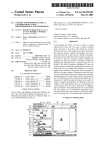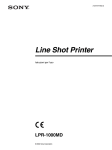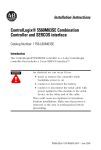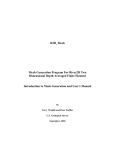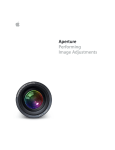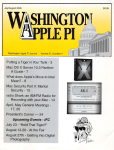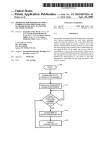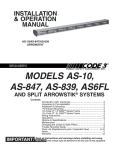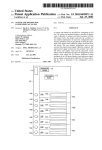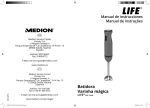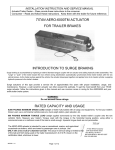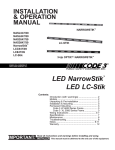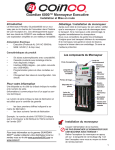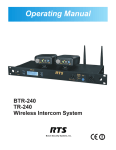Download illllllll
Transcript
US006717591B1 (12) (54) United States Patent (10) Patent N0.: Fiveash et al. (45) Date of Patent: 5,574,798 A * 11/1996 Greer et a1. .............. .. 382/100 DYNAMICALLY CONTROLLING THE 6,108,001 A * Bott, Ed. “Using Microsoft Office 2000”. Que Publishing, 1999: p. 514* Inventors: William Alton Fiveash, Austin, TX * Cited by examiner (US); Denise Marie Genty, Austin, TX (Us); Gerald Francis McBrearty, Austin, TX (Us); ShaWIl Patrick Primary Examiner—]ohn Cabeca Assistant Examiner—Brian DetWiler (74) Attorney, Agent, or Firm—Diana Roberts; Volel Emile; Mullen, Buda, TX (US); Johnny Meng-Han Shieh, Austin, TX (US) Jerry Kraft (57) ABSTRACT For a presentation comprising a plurality of presentation segments, timing is established through the combination of asslgnmg a pOmOn of a. total presentanoti mm .to each Of.the patent ls extended or adJusted under 35 plurallty of presentatlon segments, dlsplaymg the tlme . d t h f .d t t. t b1. U‘SC. 154(k)) by 466 days. asslgne o eac o seu presen a lon segmen s, ena mg a user to change the tlme asslgned to the segment bemg presented, and in response to a change in said time, dynami _ (21) Appl' NO" 09/652’052 (22) Filed; Aug 31, 2000 ~ 8/2000 Tuttle ....................... .. 345/730 OTHER PUBLICATIONS (73) Assignee: lnternati9nal Business Machines Corporatlon’ Armonk’ NY (Us) ( * ) Notice: Subject to any disclaimer, the term of this (52) (58) Apr. 6, 2004 COMPUTER DISPLAY SYSTEM FOR PACING OF SEQUENTIAL PRESENTATION SEGMENTS IN RESPONSE TO USER VARIATIONS IN THE TIME ALLOCATEI) TO SPECIFIC PRESENTATION SEGMENTS (75) US 6,717,591 B1 ~ ~ ~ ~ ~ ~ ~ ~ ~ ~ ~ ~ ~ ~ ~ ~ ~ ~ ~ ~ ~ ~ ~ ~ ~ ~ ~ ~ cally reapportioning the remaining total time among the subsequent sequential presentation segments. The reappor tioned times for said subsequent sequential presentation ~ ~ ~ ~ ~ ~ ~ ~ ~ ~ ~ ~ ~ ~ ~ ~ ~ ~ ~ - US. Cl. ...................................... .. 345/ 732; 345/723 Field of Search ............................... .. 345/730, 731, 345/732, 723, 726 means, responsive to the change in the time, for dynamically eliminating one of said sequential segments. In slide presentations, there may be means for displaying the reap portioned times for said subsequent sequential individual (56) References Cited slides together With miniaturizations of each of said subse quent sequential individual slides. U.S. PATENT DOCUMENTS 5,035,624 A * 7/1991 21 Claims, 8 Drawing Sheets Hosoya et a1. ............ .. 434/309 — I Microsoft PowerPoini- (expensesppl) File Edit View Go Bookmarks Options Directory Window Help HUB UUUUU BU Location: I Bumm SQOWEI‘L Simorls and Parks Map 0 step two »nlan three step two - 50 n three plans worked lma etc and etc E 521 @2 52 3 llwtlz Charting Forums: 199‘ PROFEX Confer-nu 1 l illllllll Aland! I: m -step one Jollow the plans slated etc. and etc my, cum Madison, Wl 4 52 [ml 5 52 [m 6 52 U.S. Patent Apr. 6, 2004 Sheet 6 0f 8 US 6,717,591 B1 @ SET UP A COMPUTER CONTROLLED DISPLAY INTERFACE TO SHOW MINIATURE SLIDES IN PRESENTATION SEQUENCE I SET UP DISPLAY PROMPTING PROCESS FOR REQUESTING INTERACTIVE DISPLAY INPUT AS TO TIME THAT EACH SLIDE IS TO BE PRESENTED L62 I FIG. 6 SET UP ROUTINE FOR TRACKING THE REAL TIME FOR EACH SLIDE DURING PRESENTATION \,63 I SET UP PROCESS FOR AUTOMATICALLY SWITCHING SLIDES BASED UPON USER TIME INPUT I SET UP PROCESS FOR USER MANUAL OVERRIDE OF SWITCHING TIME I SET UP PROCESS TO ENABLE USER TO PROVIDE ALGORITHM TO REAPPORTION REMAINING OVERALL PRESENTATION TIME DYNAMICALLY AMONG REMAINING SLIDES IN THE PRESENTATION SEQUENCES IN RESPONSE TO A USER MANUAL OVERRIDE OF TIME I ENABLE THE USER TO ELIMINATE SOME REMAINING SLIDES IN SEQUENCE VIA THE ALGORITHM U.S. Patent Apr. 6, 2004 PROMPT USER FOR Sheet 7 of 8 US 6,717,591 B1 N 70 SLIDE TIMES I FIG. 7 SET UP TIME AND U, 71 SWITCH SEQUENCE PRESENT NEXT SLIDE N 72 73 74 MANUAL OVERRIDE NO COMPUTE REMAINING TOTAL PRESENTATION TIME LESS EXTRA N 75 TIME OF OVERRIDE LAST SLIDE? I REAPPORTION REMAINING TIME AMONG REMAINING SLIDES DYNAMICALLY AS PER USER SET UP END ALGORITHM PRESENTATION I RESET TIMES FOR REMAINING SLIDES N 77 U.S. Patent Apr. 6, 2004 Sheet 8 of 8 US 6,717,591 B1 FIG. 8 ALGORITHM SET UP Tt = TOTAL PRESENTATION TIME; Ta, Tb, Tc, Td, Te and TfARE THE x 81 USER SET TIMES FOR EACH SLIDE; Tr = REMAINING TIME AFTER A: MANUAL OVERRIDE ON TIME Ta, THEN IF Tr = or>20 MINUTES, _ OIvIOE Tr BY 5 AND SET SLIDE TIME = ’\/ 82 Tr/5 FOR OTHERS. IF Tr<20 MINUTES, SET TIME FOR EACH OF OTHERS AT Tr-4/4. ___, AFTER A: MANUAL OVERRIDE ON TIME Td, THEN IF Tr<10, DROP SLIDE Te AND SET Tf=Tr; OTHERWISE SET Tr/2 FOR EACH OF TWO REMAINING SLIOES EXIT x 83 US 6,717,591 B1 1 2 COMPUTER DISPLAY SYSTEM FOR DYNAMICALLY CONTROLLING THE According to one aspect of the present invention, each of said presentation segments is a presentation of an individual slide. This aspect also may include the means responsive to the change in the time for dynamically eliminating one of PACING OF SEQUENTIAL PRESENTATION SEGMENTS IN RESPONSE TO USER VARIATIONS IN THE TIME ALLOCATED TO SPECIFIC PRESENTATION SEGMENTS said sequential slides. In slide presentations, there may be means for displaying the reapportioned times for the subsequent sequential indi vidual slides including means for displaying a screen includ TECHNICAL FIELD The present invention relates to user interactive computer ing miniaturiZations of each of the subsequent sequential 10 supported display technology and particularly to display individual slides together With means for the displaying of the reapportioned time for each slide adjacent to each slide. systems for controlling the timing of presentations com prised of a sequence of presentation segments. BRIEF DESCRIPTION OF THE DRAWINGS BACKGROUND OF RELATED ART 15 The past decade has been marked by a technological revolution driven by the convergence of the data processing draWings, in conjunction With the accompanying speci?cation, in Which: industry With the consumer electronics industry. As a result of these changes, it seems as if virtually all aspects of human FIG. 1 is a block diagram of an interactive data processor endeavor in the industrialiZed World requires human controlled display system including a central processing unit computer interfaces. There is a need to make computer directed activities accessible to many people Who Were, until recently, computer indifferent. There are great numbers of potential users highly skilled in a variety of technological, business and educational ?elds Who use computers only to the eXtent absolutely necessary. Thus, they use computers The present invention Will be better understood and its numerous objects and advantages Will become more appar ent to those skilled in the art by reference to the folloWing Which is capable of dynamically reapportioning remaining total time among the subsequent sequential presentation segments in response to a change in said time assigned to a 25 sequential segment; for Word processing and Internet access but are resistant to other signi?cant functions. These users are resistant because FIG. 2 is a diagrammatic vieW of a display screen With miniaturiZed versions of a sequence of slides to be presented With dialog entry ?elds beloW each slide prompting a user they consider the other computer controlled functions not entry of the presentation time assigned to each slide; user friendly, i.e. the applications are not intuitive or FIG. 3 is the display screen of FIG. 2, Wherein the user has dynamic. The functions require an initial investment of time in the learning curve and must be continually used or they entered his designated presentation times for each slide in the sequence; FIG. 4 is the display screen of FIG. 3 after the user has Will be easily forgotten. Computer controlled or computer aided presentations is one such category of computer func tions. These applications, such as PoWerpointTM, discussed in great detail in the teXt, Using MicrosoftTM 35 ing slides after the overridden slide; PoWerpointTM97, by N. Stevenson et al., published by Que, Indianapolis, Ind., 1997, have provided excellent presenta FIG. 5 is the display screen of FIG. 3 after the user has manually overridden the designated time for one of the slides, but With one of the slides eliminated from the tion tools to teachers and academic lecturers Who regularly make such presentations. On the other hand, other potential users in the business and technological ?eld Who make presentations less frequently have shoWn a resistance to such presentation applications because of a real or perceived impression that the applications are not intuitive or dynamic enough for the casual or less regular user. presentation, and shoWing the reapportioned times for the remaining slides; FIG. 6 is a general ?oWchart of a program set up to 45 SUMMARY OF THE PRESENT INVENTION recalculating remaining times for each remaining slide time after a manual override has been done. 55 DETAILED DESCRIPTION OF THE PREFERRED EMBODIMENT Referring to FIG. 1, a typical data processing system is shoWn Which may function as the computer controlled display terminal used in controlling the presentation of the instant invention. A central processing unit (CPU) 10, such as one of the PC microprocessors or Workstations, e.g. RISC tioning remaining total time among the subsequent sequen tial presentation segments. System/6000TM (RS/6000) series available from Interna tional Business Machines Corporation (IBM), is provided and interconnected to various other components by system The invention preferably also includes means for display ing the reapportioned times for said subsequent sequential said sequential segments. tial presentation segments in response to a change in said time assigned to a sequential segment; up in accordance With the ?oWchart of FIG. 6; and FIG. 8 is the ?oWchart of an algorithm for dynamically presentations more intuitive and dynamic, even to the casual user. The implementation is directed to the pacing of pre presentation segments. There may also be means, responsive to the change in the time, for dynamically eliminating one of implement the present invention of dynamically reappor tioning remaining total time among the subsequent sequen FIG. 7 is a ?oWchart of an illustrative run of a program set The present invention provides an implementation Which makes the giving of computer controlled or computer aided sentations made up of a plurality of presentation segments and comprises the combination of means for assigning a portion of a total presentation time for each of said plurality of presentation segments; means for displaying the time assigned to each of said presentation segments; means enabling an interactive user to change, during the presenta tion of a segment, the time assigned to the segment being presented; and means responsive to a change in said time assigned to a sequential segment for dynamically reappor manually overridden the designated time for one of the slides and shoWing the reapportioned times for the remain 65 bus 12. An operating system 41 runs on CPU 10, provides control and is used to coordinate the function of the various components of FIG. 1. Operating system 41 may be one of the commercially available operating systems such as the US 6,717,591 B1 3 4 AIX 6000TM operating system available from IBM; entering the time for the segment in each dialog box 51. The Microsoft’s Windows 98TM or Windows NTTM, as well as result is shown in FIG. 3 in which the total time for the UNIX and AIX operating systems. Application program 40, presentation, 30 minutes, is allocated into segments of 2, 3, controlled by the system, are moved into and out of the main 2, 3, 10 and 10 minutes for the sequence of six slides. The presentation may be set up so that the presenter will be alerted when the time for each slide segment has expired so that he may switch to the next slide. Alternatively, the presentation may be set up so that if the presenter does not memory Random Access Memory (RAM) 14. These pro grams include the programs of the present invention for controlling the timing of presentations by dynamically reap portioning remaining total time among subsequent presen manually override any of the presentation times, the slide tation segments after a manual user change to the designated time allocated to a prior presentation segment. A Read Only Memory (ROM) 16 is connected to CPU 10 via bus 12 and 10 presenter, who is currently completing his presentation of includes the Basic Input/Output System (BIOS) that controls the basic computer functions. RAM 14, U0 adapter 18 and communications adapter 34 are also interconnected to sys tem bus 12. U0 adapter 18 communicates with the disk storage device 20. Communications adapter 34 intercon nects bus 12 with an outside network enabling the data processing system to communicate with other systems. Such networked systems include a Local Area Network (LAN) or a Wide Area Network (WAN), which includes, of course, the World Wide Web (Web) or Internet. The present invention is applicable to remote presentations made to locations remote from the presenter using such communication networks. I/O 15 through 8 only has 18 minutes of remaining time instead of the original 22 minutes and reduces the time for the remain ing three slides to 2, 8 and 8 minutes each as indicated in their respective associated boxes 54, 55 and 56. The user may set up any convenient algorithm for dynamically real locating the remaining time as the user consumes extra time on any particular presentation slide segment. For example, the algorithm in response to particular time overages may 25 interface adapter 22. It is through such input devices that the user may interactively relate to Web pages. Display adapter a result of the user having consumed 9 minutes on the presentation segment of slide “3”. 36 includes a frame buffer 39, which is a storage device that holds a representation of each pixel on the display screen 38. Images may be stored in frame buffer 39 for display on monitor 38 through various components, such as a digital to Now, with reference to FIG. 6, we will describe the setting up or development of a program according to the present invention for dynamically reapportioning remaining total time among the subsequent sequential presentation seg analog converter (not shown) and the like. By using the aforementioned I/O devices, a user is capable of inputting ments in response to a change in said time assigned to a 35 larly for text, or mouse 26 and receiving output information from the system via display 38 and set up in frame buffer 39. In the description which follows of the slide presentation embodiment, the user interactively controls via display screens on display 38, and a slide projector may be stepped through a slide stepping mechanism connected via user sequential segment in a sequential segmented presentation, which, in this example, will be a slide presentation. First, there is provided a standard program for controlling slide presentations such as PowerPoint 97 which provides an interface for displaying the selected sequence of slides in sequential miniaturiZed versions, step 61. Then, there is set up a display like that of FIG. 2 wherein the presenter-user is interface adapter 22. prompted to enter the times during which each sequential slide is to be displayed, step 62. A routine is provided for There will now be described a simple illustration of the present invention with respect to the display screens of FIGS. 2 through 5. When the screen images are described, it will be understood that these may be rendered by storing image and text creation programs, such as those in any conventional window operating system in the RAM 14 of completely eliminate one or more selected slide presentation segments. This is illustrated in the display screen of FIG. 5 where slide segment “4” has been completely eliminated as and mouse 26 are all interconnected to bus 12 through user information to the system through the keyboard 24, particu slide “3” which is indicated as the current slide by high lighting 60, FIG. 4, has overridden or overrun the designated time of 2 minutes, and has instead used 6 minutes. The process to be hereinafter described with respect to FIGS. 6 devices are also connected to system bus 12 via user interface adapter 22 and display adapter 36. Keyboard 24 sequence will automatically be switched as the time allo cated for the slide segment ends. Now, assume that the timing each slide presentation segment, step 63. Aprocess is 45 set up for automatically switching from slide to slide in the sequence based upon the user input times, step 64, or for permitting the presenter to overrun the time for any desig nated slide segment. Aprocess is provided whereby the user the system of FIG. 1. The operating system is diagrammati cally shown in FIG. 1 as operating system 41. The display may manually override or overrun the predesignated times for any of the slides in the sequence, step 65. Aset up is then screens of FIGS. 2 through 5 are presented to the viewer on provided whereby the presenter is enabled to provide an display monitor 38 of FIG. 1. In accordance with, algorithm for the dynamic reapportionment of remaining conventional techniques, the user may control the screen overall presentation time among the remaining slides in the interactively through a conventional I/O device, such as mouse 26 of FIG. 1. presentation sequence in response to a user manual override 55 With reference to FIG. 2, an illustrative data entry display of the designated time for any slide segment, step 66. This algorithm provision may even include the ability to have the screen is shown. This is the dialog screen offered to users algorithm eliminate one or more remaining slides from the organiZing the presentation. On the control display window presentation, step 67. Now that the basic program set up has been described, 50, the user-presenter sets up a sequence of miniature versions 51 of his sequence of slides to be presented, numbered 1 through 6. The setting up of such a sequence of slide miniatures 51 is described in detail in the above there will be described with respect to FIG. 7 a ?ow of a simple operation showing how the program could be run to dynamically control the slide presentation. First, the pre senter is prompted for the times for each slide presentation mentioned N. Stevenson et al. text at pp. 321—324. The present invention adds a plurality of dialog boxes 52, each respectively associated with one of the slide miniatures 51. The presenter is prompted to organiZe the presentation so as to allocate the time for each slide presentation segment by 65 segment, step 70. The time and switch slide sequences are set up accordingly, step 71. The ?rst or next slide is switched to and presented, step 72. For each slide, the end of the time segment is determined, step 73. If No, the ?ow is returned US 6,717,591 B1 6 5 to step 73 Where the time end is awaited. If Yes, then a further determination is made as to Whether there has been means for displaying the time assigned to each of said an override or overrun by the user, step 74. If No, a determination may conveniently be made here as to Whether means enabling an interactive user to change, during the this is the last slide in the presentation, step 78. If Yes, the presentation is ended. If No, then the process is returned to step 72 Where the presentation is sWitched to the neXt slide. HoWever, if the determination is made in step 74 that Yes, means responsive to a change in said time assigned to a presentation segments; presentation of a segment, the time assigned to the segment being presented, and sequential segment for automatically dynamically reap portioning remaining total time among the subsequent there is an overrun or override, the remaining total time less sequential presentation segments. the eXtra time of the manual override is computed, step 75, and this remaining time is dynamically reapportioned 2. The computer display system of claim 1 further includ ing means for displaying the reapportioned times for said betWeen the remaining slides in accordance With an appro priate algorithm as set up by the user, step 76. The times are subsequent sequential presentation segments. then reset accordingly for the remaining slides, step 77, and the process is returned to step 72 Where the presentation is sWitched to the neXt slide. 15 With respect to FIG. 8, there Will be described an eXample of said presentation segments is a presentation of an indi vidual slide. of a typical algorithm for time reapportioning. Algorithm Set Up, Step 81 5. The computer display system of claim 4 further includ ing means for displaying the reapportioned times for said Tc=Total Presentation Time. Ta, Tb, Tc, Td, Te and Tf are the user Preset times for each slide. subsequent sequential individual slides. 6. The computer display system of claim 5 Wherein said means for displaying the reapportioned times include: Tr=Remaining Time Thus, the algorithm of step 82 is set up With respect to Ta means for displaying a screen including miniaturiZations 25 so that if there is an overrun or override and Tr is 20 minutes time. If Tr is less than 20, then Tb is set at 4 minutes dynamically and each of the other segments is set at Tr minus 4 divided by 4. There can be a different algorithm equation for each slide matically dynamically eliminating one of said sequential individual slides. segment of the presentation. In step 83, another algorithm equation is set forth; for example, for changes associated 35 said plurality of presentation segments; segments; enabling an interactive user to change, during the presen tation of a segment, the time assigned to the segment One of the preferred implementations of the present being presented; and responsive to a change in said time assigned to a sequen 45 presentation segments. 9. The method of claim 8 further including the step of displaying the reapportioned times for said subsequent sequential presentation segments. input. Further, the program instructions may be stored in the memory of another computer prior to use in the system of 10. The method of claim 9 further including the step of automatically dynamically eliminating one of said sequen tial segments response to said change in said time. the present invention and transmitted over a LAN or a WAN, 55 12. The method of claim 11 further including the step of Although certain preferred embodiments have been 13. The method of claim 12 Wherein said step of display ing the reapportioned times includes: displaying a screen including miniaturiZations of each of said subsequent sequential individual slides; and displaying the reapportioned time for each slide adjacent 1. A computer display system for interactively controlling the timing of a presentation having a plurality of sequential for each of said plurality of presentation segments; 11. The method of claim 7 Wherein each of said presen tation segments is a presentation of an individual slide. displaying the reapportioned times for said subsequent sequential individual slides. shoWn and described, it Will be understood that many changes and modi?cations may be made therein Without departing from the scope and intent of the appended claims. What is claimed is: means for assigning a portion of a total presentation time tial segment, automatically dynamically reapportioning remaining total time among the subsequent sequential program instructions may be stored in another readable medium, eg in disk drive 20 or in a removable memory such as an optical disk for use in a CD ROM computer input or in a ?oppy disk for use in a ?oppy disk drive computer presentation segments comprising: tial presentation segments comprising: displaying the time assigned to each of said presentation invention is in application program 40, ie a program made up of programming steps or instructions resident in RAM such as the Web itself, When required by the user of the present invention. One skilled in the art should appreciate that the processes controlling the present invention are capable of being distributed in the form of computer read able media of a variety of forms. 8. A method for interactively controlling the timing of a computer display presentation having a plurality of sequen assigning a portion of a total presentation time for each of ing time. 14, FIG. 1. Until required by the computer system, the of each of said subsequent sequential individual slides, and means for the displaying the reapportioned time for each slide adjacent to each slide. 7. The computer display system of claim 6 further includ ing means, response to said change in said time, for auto or more, then Tr, the remaining time is divided by 5, and each of Tb—Tf is dynamically assigned 1/5 of the remaining With segment Td of the presentation. Thus, if there is an overrun or override at segment Td, then if the remaining Tr is less than 10 minutes, slide segment Te Will be dropped from the presentation and the remaining segment Tf Will set to the remaining time Tr. OtherWise, the tWo remaining slide segments are each dynamically allocated half of the remain 3. The computer display system of claim 2 further includ ing means, responsive to said change in said time, for automatically dynamically eliminating one of said sequen tial segments. 4. The computer display system of claim 1 Wherein each to each slide. 65 14. The method of claim 13 further including the step of automatically dynamically eliminating one of said sequen tial individual slides response to said change in said time. US 6,717,591 B1 8 7 18. The computer program of claim 15 Wherein each of said presentation segments is a presentation of an individual slide. 19. The computer program of claim 18 further including means for displaying the reapportioned times for said sub 15. A computer program having code recorded on a computer readable medium for interactively controlling the timing of a computer display presentation having a plurality of sequential presentation segments comprising: means for assigning a portion of a total presentation time for each of said plurality of presentation segments; sequent sequential individual slides. means for displaying the time assigned to each of said presentation segments; 20. The computer program of claim 19 Wherein said means for displaying the reapportioned times include: means enabling an interactive user to change, during the presentation of a segment, the time assigned to the means for displaying a screen including miniaturiZations segment being presented, and means responsive to a change in said time assigned to a of each of said subsequent sequential individual slides, sequential segment for automatically dynamically reap portioning remaining total time among the subsequent sequent sequential presentation segments. and means for the displaying the reapportioned time for each slide adjacent to each slide. 21. The computer program of claim 20 further including means, response to said change in said time, for automati 17. The computer program of claim 16 further including means, response to said change in said time, for automati vidual slides. sequential presentation segments. 16. The computer program of claim 15 further including means for displaying the reapportioned times for said sub cally dynamically eliminating one of said sequential seg ments. 15 cally dynamically eliminating one of said sequential indi













